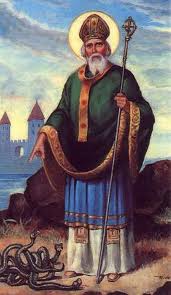Lá fhéile Pádraig sona dhaoibh! Happy St. Patrick’s day to you all!
I grew up in a family where we frequently and vocally celebrated our Irish heritage. My dad could often be seen sipping on a tall pint of thick, black Guinness, or tapping away on a bodhrán while singing a traditional Irish tune. My mom incorporated Celtic pagan traditions into our holiday celebrations and introduced us to Irish mythology. My younger siblings are named Shane and Siobhán. We even lived for a year in County Clare, just west of Lough Derg.
Because of this Irish-centric upbringing, I have mixed feelings about St. Patrick’s day. On the one hand, I’m happy that people want to celebrate the history of the Irish people and their impact on modern American culture. On the other hand, the whole kiss-me-I’m-Irish, dress-up-like-a-leprechaun, drink-green-beer-’til-I-puke thing is less than amusing, and some might argue even demeans the Irish heritage is claims to celebrate. So, to bring some sobering truth to an otherwise raucous holiday, I thought I’d share some facts about St. Patrick that you might not otherwise know!
1. St. Patrick wasn’t actually Irish.
Surprise! Patrick was born sometime in the 4th or 5th century AD in Roman Britain (various sources point to Cumbria, Scotland, and Wales as likely birth places for Patrick) to a family of Christian deacons and priests. He was kidnapped as a teenager by Irish pirates, and enslaved as a shepherd for a number of years until he was able to escape and return home to his family. Years later, he returned to Ireland as a Christian missionary, presumably to convert the pirates (!) and slave-owners (!) he had become so familiar with.
2. His name probably wasn’t Patrick.
Sorry again. Most sources agree that Patrick was born Maewyn Succat, to parents Calpurnius and Conchessa. The name Patrick most likely arises from his time as a missionary in Ireland. Tírechán, a 7th century Irish bishop and biographer of St. Patrick, writes:
I found four names for Patrick written in the book of Ultán…: holy Magonus (that is, “famous”); Succetus (that is, the god of war); Patricius (that is, father of the citizens); Cothirtiacus (because he served four houses of druids).
So, the name Patrick likely derives from Patricius, meaning father of the citizens.
3. He’s not technically a Saint.
I know! For most of the first millennium of Christianity, sainthood was bestowed on a regional or diocesan level. Basically, when a holy person died, the local Church would affirm them to be liturgically celebrated as saints by the locals. This means that St. Patrick was never formally canonized by the Pope. That being said, many Christian churches accept him to be a Saint in Heaven, and he is widely venerated as such in Ireland and elsewhere.
4. There’s no way he actually banished all the snakes from Ireland.
Sorry, but St. Patrick was neither a powerful wizard nor did he speak Parseltongue. As legend would have it, St. Patrick banished every last snake from the island after they attacked him during a 40-day fast on the top of a hill (I’d be grouchy too). However, experts agree that post-glacial Ireland never had snakes in the first place, so there wasn’t anything for Patrick to banish. It is more likely that the story metaphorically refers to Patrick bringing Christianity to the island and “driving out” the “devil” in the form of druidism, paganism, and other indigenous religious belief systems.
5. St. Patrick has become one of the most symbolically resonant figures in Irish history.
Despite all this, the tradition of Maewyn Succat a.k.a. Patricius a.k.a St. Patrick has been given new layers of meaning over time and now features solidly in the cultural and historical identity of Ireland. St. Patrick not only represents the arrival of Christianity in Ireland, but also the merging of indigenous religious and mythic traditions with Christianity in a broader framework of cultural hybridity. The date of his death, March 17th, has become both a holy Feast Day and a global holiday celebrating Irish culture. St. Patrick is a symbol of patriotism and cultural pride, along with the color green and the shamrock.
I’ll leave you with a traditional Irish blessing on this Feast Day/day of celebration:
May the road rise up to meet you.
May the wind be always at your back.
May the sun shine warm upon your face;
the rains fall soft upon your fields and until we meet again,
may God hold you in the palm of His hand.
Sláinte! Cheers to your health, and be safe!



Ha! I love this! Thank you for sharing it! I too have strong Irish roots and have mixed feelings on the holiday. So in the past years, hubs (who recently learned he too has Celtic roots) and I have kind of reclaimed the day and use it as a reminder to remember where our peoples came from.We fix traditional Irish fare and toast each other with a pint of Guinness. We kind of leave out all the “St. Patrick” shtuffs.
Glad you enjoyed it! Ditto for us, we usually try to find an Irish pub with a live session and enjoy a pint of Guinness in a traditional atmosphere. It’s a great way to remember and celebrate both the triumphs and the struggles of the Celtic peoples I am descended from!
Another myth….. using the shamrock to explain the concept of Trinity to Druids. Celtic deities all had triple aspects, so the concept was well understood. In fact, it was a Gaulic monk who first wrote about the Trinity and introduced it into Christian dogma.
Interesting! I knew about the triple aspects of celtic deities, but didn’t know that about the monk.
Yes, so much of modern Christian dogma arose from assimilation and cultural hybridity, especially from the Celtic tradition. Did you get a chance to read my Celtic Christmas post from a while back? You might enjoy it. http://spellboundscribes.wordpress.com/2013/12/16/the-celtic-roots-of-christmas/
Glad you and Mom exposed me to all the fascinating aspects of the Irish Celtic traditions! Happy St. Patrick’s day, however you choose to celebrate it!